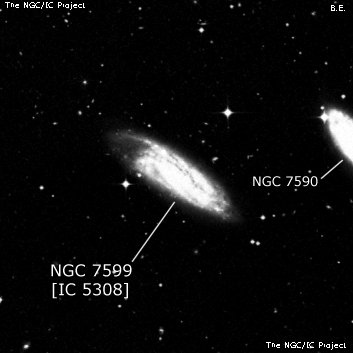
James Dunlop discovered NGC 7599 = D 477.2 = h3981, along with NGC 7582, on 14 Jul 1826 and recorded "two very small round nebulae, nearly the same RA, and differing about 1' in polar distances." John Herschel observed the pair of 2 Sep 1836 and logged "F; pmE; gbM; 3'; [the following of two]."
Harold Corwin notes that Lewis Swift's XI-227 = IC 5308, found on 8 Aug 1897 and described as "eeF; S; cE; f of 3; f of 7599.", is probably a duplicate observation. Swift likely confused NGC 7590 as 7599 and assumed Sw. XI-227 was new. See Corwin's historical notes.
300/350mm - 13.1" (11/5/83): extremely faint, fairly large, very elongated SW-NE, at visual threshold. Located 4.9' ESE of NGC 7590. Faintest of three nearly edge-on galaxies in the field (Grus Quartet including NGC 7552). Observation hampered by very low elevation from Northern California.
600/800mm - 30" (10/21/17 - OzSky): NGC 7599 is the third in the showpiece Grus Trio. At 264x it appeared very bright, very large, elongated nearly 3:1 SW-NE, ~3.25'x1'. It was broadly concentrated but there was no distinct core or nucleus. The surface brightness was uneven or mottled, though, likely due to spiral structure or dust. The southwest end appeared more tapered and had a very faint extension at the tip, while the northeast side ends more abruptly. A mag 14 star is superimposed on the north side, 0.8' NNE of center. A mag 12.8 star is off the east side, 1.5' from center. NGC 7590 lies 5' WNW.
Notes by Steve Gottlieb